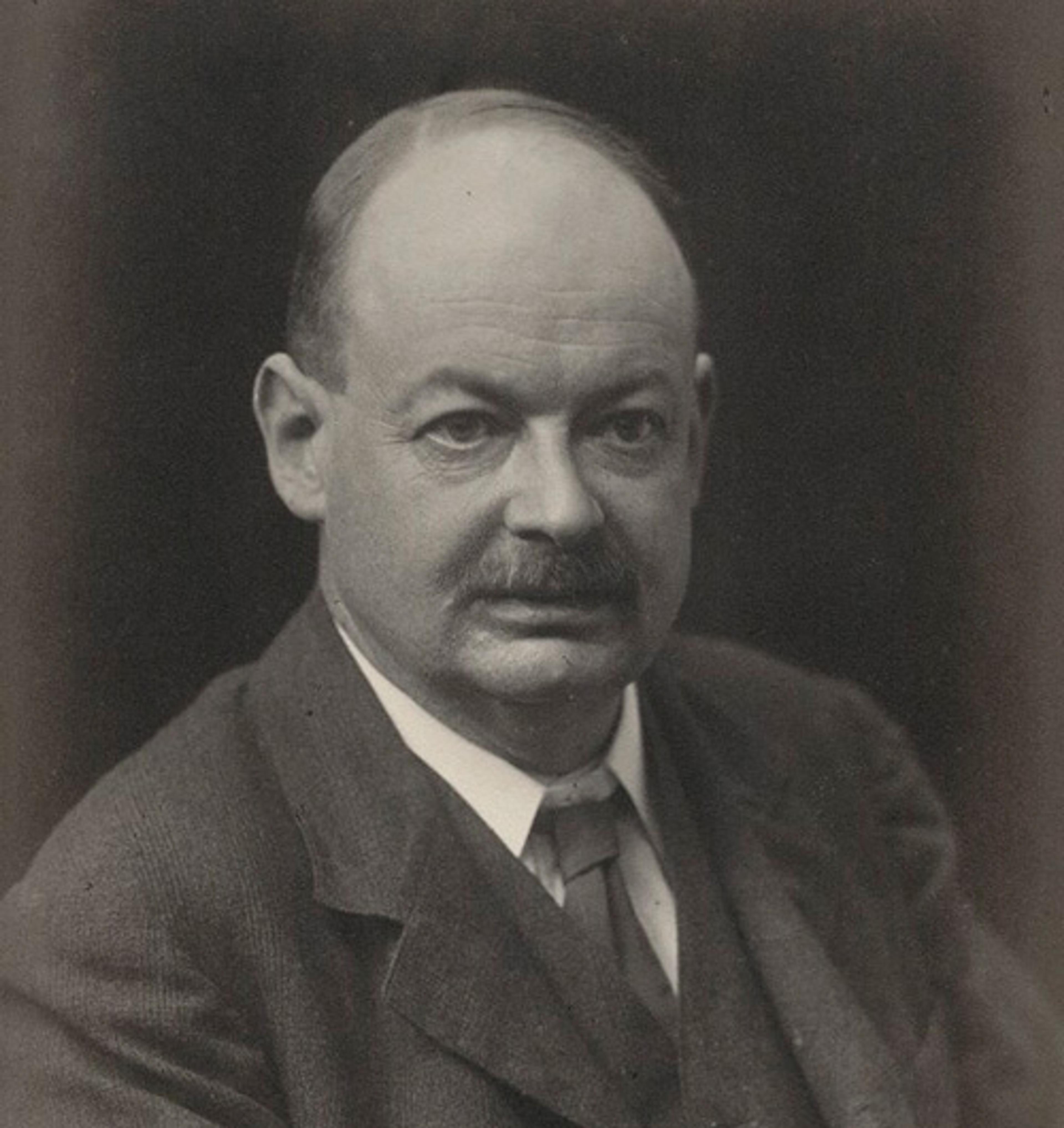Events happen in order – you whisk icing before decorating a cake. Some events seem to be present, while others are future or past. A birthday party lies in the future, approaching slowly. When the big day arrives, the party is present; afterwards, it slips into memory and the past. Pastness, presentness and futurity seem to be real features of the world, but are they really? Philosophers disagree, and this debate pervades books such as Time and Space (2001) by Barry Dainton, and A Companion to the Philosophy of Time (2013), edited by Adrian Bardon and Heather Dyke.
How did this disagreement come about? Although it sounds like the sort of thing that philosophers have wrangled over for millennia, I say it’s relatively recent. I think the debate was started just over 100 years ago, by one man: John McTaggart Ellis McTaggart.

John McTaggart Ellis McTaggart, c1917. Photo courtesy Wikimedia
McTaggart was a Cambridge philosopher, working in Trinity College through the turn of the 20th century. Of their first meeting, Bertrand Russell wrote that he was ‘even shyer than I was’: McTaggart was too shy to enter Russell’s room, and Russell too shy to ask him in. Russell and McTaggart were part of the ‘Mad Tea Party of Trinity’: Russell the Mad Hatter, and McTaggart with his ‘innocent, sleepy air’ the Dormouse. Despite his gentleness, McTaggart was ingenious. A colleague observed that McTaggart ‘added greatly to the gaiety of college meetings’, for he was liable to use arguments that ‘everyone accepted, to support conclusions which no one else had thought of’.
From his earliest work, McTaggart obsessed over time. In itself, this was not unusual – during this period, many philosophers were similarly absorbed. What was unusual is how McTaggart thought about time.
Like most human things, philosophy has fashions. In Western philosophy, time jumps on and off the menu. Medieval philosophers occasionally puzzled over time, with Augustine and Thomas Aquinas pondering God’s eternity. Time became a huge topic from the mid-17th century, when debate raged over ‘absolutism’. Isaac Newton and other absolutists held that time is a kind of being, independent of the created world.
By the mid-18th century, time had slipped off the menu again, especially in Britain. Major British philosophers of this era ignored time, including Jeremy Bentham, Adam Smith, Edmund Burke, George Jardine, Mary Wollstonecraft. This was partly due to the Scottish Enlightenment, which discouraged studying abstract, abstruse topics. British interest picked up following the work of the German philosopher Immanuel Kant, but this attitude shift took decades to arrive.
Kant’s Critique of Pure Reason (1781) put a new spin on time. He twists an argument made by absolutists. Many absolutists argued that we cannot imagine deleting time from the Universe. Even if you destroyed the Universe, time would remain, implying that time exists independently of us. Kant argues that the fact that we cannot dis-imagine time doesn’t tell us anything about the Universe. Instead, it tells us something about our minds. Time is rooted in us: it is a form of thought, a precondition for experiencing anything. Human minds are wired such that our experiences are always temporal, and that’s why we can’t even imagine a nontemporal world. Nonetheless, the world outside our heads, as it really is independent of us, might be nontemporal. Because we must perceive things in time, we don’t know what things-in-themselves are like.
For Kant, human minds play an active role in constructing our perceptions. The world-in-itself might not be temporal, but the world that humans perceive is. This is a form of ‘idealism’, a family of views stressing the activity of mind.
After Kant, idealism swept Germany. But it took ages to arrive in Britain. The Scottish philosopher William Hamilton offered the first serious engagement with Kant in 1836: that’s more than 50 years after the Critique. Nonetheless, after Hamilton, idealism sprouted in Britain, blooming into the movement known as ‘British idealism’ in the 1860s. By then, British philosophers were mixing their Kant with G W F Hegel, and idealism of all kinds ran rife.
Idealism came parcelled with the unreality of time. Almost every British idealist rejected time, from T H Green to F H Bradley. McTaggart arrived at Cambridge as a student in 1885, by which period accepting idealism and rejecting time was de rigueur. He embraced these views, producing chunky tomes on Hegel, leavened by Kant and G W Leibniz.
The rain falling was once present, and is now past. The thunder lies in the future but will be present
Although there was nothing unusual in McTaggart rejecting time, there was something unusual about how he did so. McTaggart thought hard about what time might be like if it were real. This emerges in his paper ‘The Unreality of Time’ (1908).
Imagine three events: a rainstorm, a flash of lightning, and rumble of thunder. How do we order them?

McTaggart put events into two series. Both the ‘A-series’ and the ‘B-series’ order events according to whether they are earlier or later. The lighting flashes after the rain starts, and before the thunder rumbles.
Additionally, the A-series takes some event to be special: ‘present’. It brands earlier events ‘past’, and later ones ‘future’. If the lightning flash is present, then rain fell in the past, and thunder will growl in the future.
McTaggart’s argument against time has two steps. First, he argues that the A-series is essential to time. On the B-series, nothing changes, for every event will always occupy the same position in time: the lightning will always flash after the rain. In contrast, on the A-series, things really change as the present moves on: the rain falling was once present, and is now past. The thunder lies in the future but will be present. McTaggart claims that time must involve this kind of change, from future to present to past.
Second, McTaggart argues that the A-series cannot exist. Being future, present and past are incompatible, contradictory properties. An event can be future or past – not both. Yet, McTaggart argues, every event has all these properties: the rainstorm was once future, then present, then past. As these properties are contradictory, he reasons that they are unreal. If the A-series is essential to time, and the A-series doesn’t exist, then time doesn’t exist. Time is unreal. He concludes that reality is timeless and changeless, even though we can’t help perceiving things in time. It’s as though we look at the world, as McTaggart put it, ‘through a window of red glass’, and so misperceive the world to be red.
What inspired McTaggart’s argument? He doesn’t tell us, but I argue that he was drawing on a new, French line of thought. In the late-19th century, Britain was basking in idealism. Meanwhile, French philosophers such as François Pillon, Charles Renouvier and Henri Bergson began stressing the importance of time. Bergson was especially widely read. From the 1880s to 1930s, he rejected what he called the ‘spatialisation’ of time. Consider this timeline, which represents time using space:
____________________________
t1 t2 t3 t4 t5
Countable moments of time are strung along a line. Time seems static, motionless. Bergson describes this spatialised time as ‘mathematical’. He argues that this misses the true, pure nature of time.
Pure time is durée. It is ‘free from all alloy’, as it doesn’t involve space. Unlike mathematical time, pure time is not divisible into countable units. Bergson implies that only conscious beings can experience pure duration. When we listen to music, a C note can melt into a D note in such a way that we cannot mark off one note from another. The past and present notes form an organic whole that cannot be divided into units, and this is how we experience durée. Pure time is melting, changing motion.
McTaggart’s argument for the unreality of time is original. Yet I suspect, in setting up the A- versus B-series, it drew on Bergsonian mathematical versus pure time. There are similarities between Bergson’s mathematical time, and McTaggart’s B-series: both eliminate past, present and future; both are changeless or motionless. There are also similarities between Bergson’s durée and McTaggart’s A-series: they stress the past, present and future, and are all about change or motion. Even if McTaggart didn’t read Bergson firsthand, Bergson was ‘in the air’ of early 20th-century Britain. From the 1900s, Bergson’s books were translated into English, and influential philosophers such as Samuel Alexander and H Wildon Carr published English-language book reviews in major journals.
McTaggart’s ‘The Unreality of Time’ soon drew fire. By the 1910s, British idealism was threatened by ‘new realism’, an anti-idealist movement stressing logic and science. Led by the likes of Bertrand Russell, G E Moore and Samuel Alexander, this movement also defended the reality of time. As realism promulgated, philosophers attacked McTaggart’s argument against time. Its early critics included C D Broad, R B Braithewaite, Susan Stebbing, John Alexander Gunn, Hilda Oakeley, J N Findlay and Victoria, Lady Welby.
As the 20th century wore on, these critiques continued. McTaggart’s paper numbered just 17 pages. Philosophers have since written tens of thousands of pages about it. Twenty-first century thinkers have cited it more than 1,600 times so far – an extraordinary achievement for a vintage journal article. You might think that these attacks would have eradicated McTaggart’s argument, but instead they invigorated it. As the saying goes: ‘All publicity is good publicity.’ The criticism kept the argument alive in the philosophical consciousness, ensuring its survival through the decades.
If all the parts of time exist, then 1066 is just as real as 2055
And, in the course of bombarding McTaggart’s argument, philosophers adopted its framework. While defending the reality of time, they aligned their realism with McTaggart’s A-series or B-series. Gradually, this process spawned two families of time theories. B-theories argue that time just is the ordering of events by before or after. Past, present and future are not features of the world: they’re just aspects of our human point of view. To say that a moment is ‘now’ is akin to saying a place is ‘here’: ‘here’ and ‘now’ depend on where you’re standing. In contrast, A-theories argue that past, present and future are real features of the world. The moment I wrote these words is really past, and you are really reading them now.
These labels acquired a life of their own, independent of McTaggart. In the 1950s, Donald Williams argued for B-theory, bellowing against the ‘repulsive’ moving present, a ‘primitive magma of confusion’. In the 1960s, Richard Gale offered an ‘impassioned defence’ of A-theory. I think the A- versus B-theory debate was at least partly fuelled by developments in physics.
Following Hermann Minkowski and Albert Einstein, a view that Williams dubbed ‘manifold theory’ gained popularity: physicists unified time and space into a single manifold, spacetime. On manifold theory, all the parts of time are as a real as the parts of space. This lends itself to B-theory, the view that ‘now’ and ‘here’ depend on your point of view. Yet some philosophers disliked manifold theory for exactly that reason: if all the parts of time exist, then 1066 is just as real as 2055. Some felt that this picture of time is too static, failing to capture time’s flow, its ‘jerk and whoosh’, as Williams put it. Philosophers who accept A-theory often reject manifold theory, denying that all the parts of time are real. For example, in 1923 Broad argued that the past and present are real, yet the future is unreal.
Today, the philosophy of time is riddled with the A- versus B-theory debate. It’s so pervasive, there is a tendency to think that this is what philosophy of time has always been about. But it isn’t. Over the past few centuries, philosophers of time have worried about divine eternity, absolutism and Kantian idealism. Our current fixation on presentness, and whether it is a real feature of the world, is a 20th-century fad. Ironically, it’s rooted in a Dormouse who rejected the reality of time altogether.
I care about the A- versus B-theory debate, and I share the A-theorist intuition that time flows. However, I care much more about the history of the debate. How did it get started? What drove McTaggart’s thinking? These origin stories matter because, I argue, the emergence of new philosophical questions signpost philosophical progress.
Our Universe is full of stuff we don’t understand. Worse – it’s full of stuff we don’t yet realise we don’t understand. To illustrate, consider black holes: regions of spacetime where gravity is so strong, not even light can escape. Twenty-first century physicists try to understand black holes. Yet this endeavour became possible only in 1916, when black holes were first theorised. Before that, physicists didn’t know there were black holes to know about.
I think similar processes occur in philosophy. Is beauty within sculptures or sunsets, or in the eye of the beholder? Does the word ‘tree’ refer to an idea in my mind, or to actual trees? When philosophers formulate new, sensible questions, they theorise new things to know about. We might not fully understand beauty, or referring, or presentness. But it is progress to know that these questions exist, regardless of whether we know the answers. In conceiving ways that time might be, McTaggart cracked open a new philosophical question about the world.






